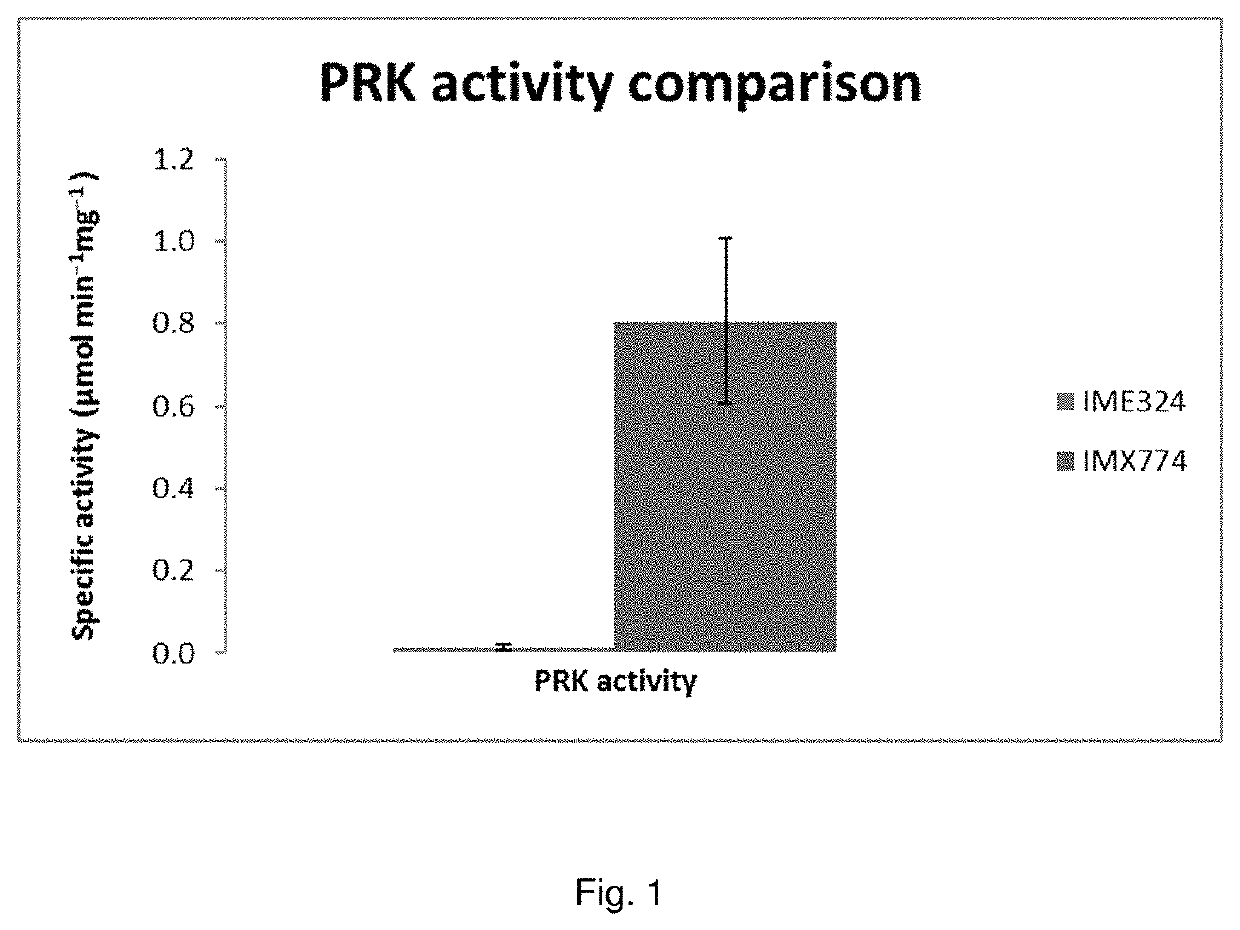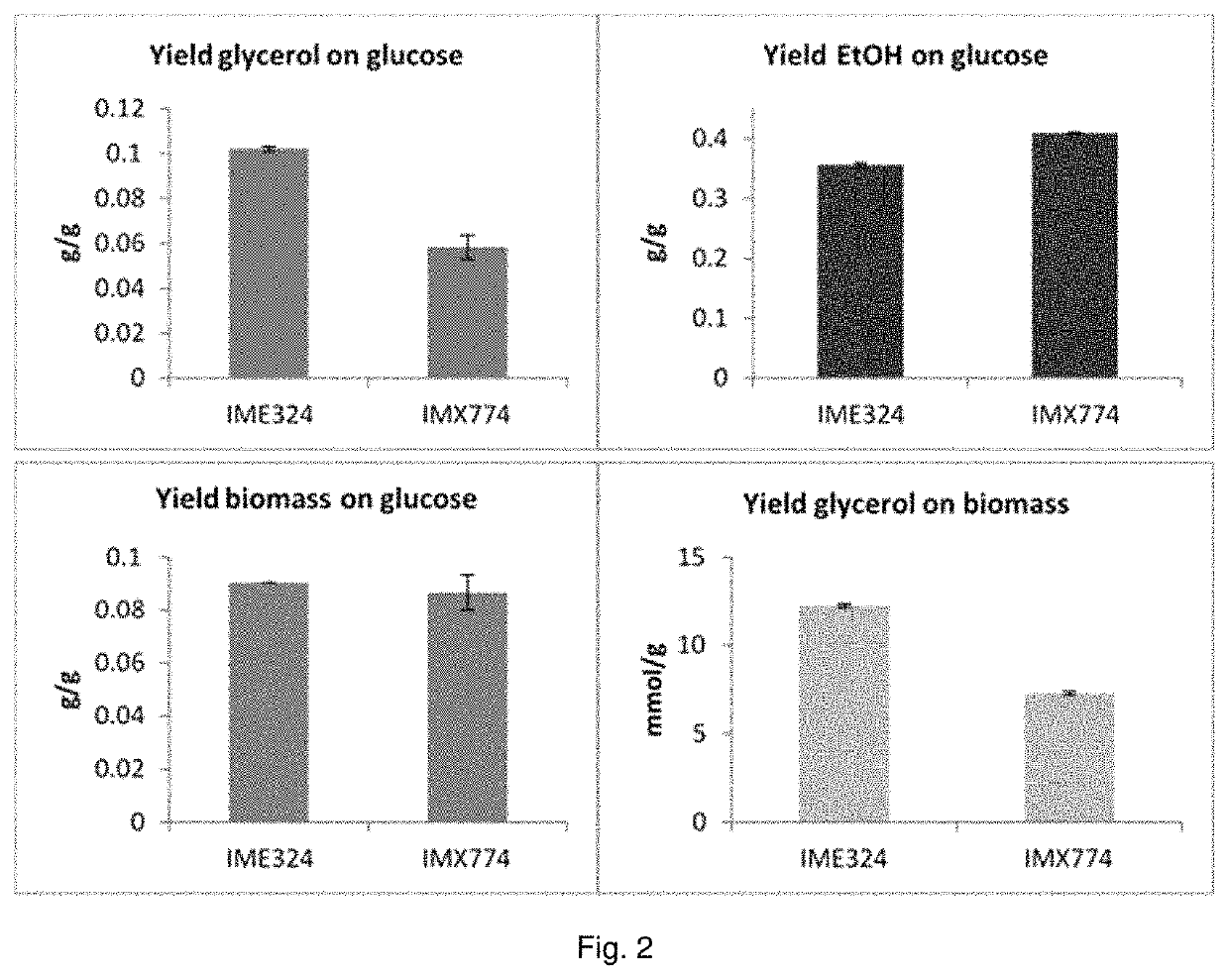Recombinant yeast cell
a technology of recombinant yeast and cell, applied in the field of recombinant yeast cell, can solve the problems of imposing waste water treatment costs, increasing process cost and complexity, and important constraints on product yield, so as to reduce side-product formation, improve propagation characteristics, and improve product yield
- Summary
- Abstract
- Description
- Claims
- Application Information
AI Technical Summary
Benefits of technology
Problems solved by technology
Method used
Image
Examples
example 1
n of DAN1p-prk in a Rubisco Expressing Strain from the CEN.PK Lineage
Maintenance of Strains
[0128]Strains originating from the CEN.PK lineage were used in this example (Table 6) [1,2]. Cultures were propagated in synthetic medium [3], supplemented with 20 g L−1 glucose. Propagation of E. coli DH5a stock cultures was performed in LB medium (5 g L−1 Bacto yeast extract, 10 g L−1 Bacto tryptone, 5 g L−1 NaCl), supplemented with 100 μg mL−1 ampicillin or 50 μg mL−1 kanamycin. Frozen stocks were prepared by addition of glycerol (30% v / v final concentration) to growing cultures and subsequent storage at −80° C.
[0129]
TABLE 6S. cerevisiae strains used in this example.Strain nameRelevant GenotypeOriginCEN.PK113-MATa ura3-52[1, 2]5DIMX585MATa URA3 can1::cas9-natNT2[4]IMX581MATa ura3-52 can1::cas9-natNT2[4]IMX675MATa ura3-52 can1::cas9-natNT2 gpd1ΔExamplesgpd2ΔIME324MATa ura3-52 can1::cas9-natNT2 p426-TEFExamples(empty)IMX765MATa ura3-52 can1::cas9-natNT2 sga1:: cbbMExamples(9 copies), groES, g...
example 4
ssion of PPP Genes and Deletion of GPD2 Gene
[0164]Genes of the non-oxidative branch of the pentose-phosphate pathway (TKL1, NQM1, TKL1, TKL2, RPE1, RKI1) were overexpressed by transforming IMX774 with expression cassettes of the abovementioned genes under control of constitutive promoters as described in pending European Patent Application EPI 6194660.3. The expression cassettes were integrated at the GPD2 locus by co-transforming the guide RNA expression plasmid with GPD2 targeting sequence, thereby abbrogating the coding sequence of gpd2. The resulting strain was named IMX1443. Strain IMX1443 was compared with IME324 and IMX774 in a batch fermentation experiment as described in Example 1. Results are listed in Table 14.
[0165]
TABLE 14Results using yeast strain with PPP genes and deletion of GPD2 geneIMX14439*cbbM, DAN1p-prk,IMX774groES, groELStrainIME3249*cbbM, DAN1p-gpd2::RPE1, TKL1, TAL1,Relevant genotypereferenceprk, groES, groELTAL2, RKI1, NQM1μ (h−1)0.33 ± 0.010.20 ± 0.030.30 ...
PUM
| Property | Measurement | Unit |
|---|---|---|
| pH | aaaaa | aaaaa |
| ionic strength | aaaaa | aaaaa |
| temperature | aaaaa | aaaaa |
Abstract
Description
Claims
Application Information
 Login to View More
Login to View More - R&D
- Intellectual Property
- Life Sciences
- Materials
- Tech Scout
- Unparalleled Data Quality
- Higher Quality Content
- 60% Fewer Hallucinations
Browse by: Latest US Patents, China's latest patents, Technical Efficacy Thesaurus, Application Domain, Technology Topic, Popular Technical Reports.
© 2025 PatSnap. All rights reserved.Legal|Privacy policy|Modern Slavery Act Transparency Statement|Sitemap|About US| Contact US: help@patsnap.com



